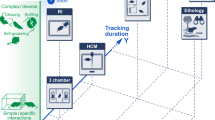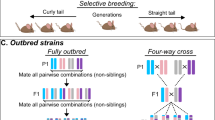Abstract
Pharmacogenomics is yet to fulfill its promise of manifestly altering clinical medicine. As one example, a predictive test for tardive dyskinesia (TD) (an adverse drug reaction consequent to antipsychotic exposure) could greatly improve the clinical treatment of schizophrenia but human studies are equivocal. A complementary approach is the mouse-then-human design in which a valid mouse model is used to identify susceptibility loci, which are subsequently tested in human samples. We used inbred mouse strains from the Mouse Phenome Project to estimate the heritability of haloperidol-induced activity and orofacial phenotypes. In all, 159 mice from 27 inbred strains were chronically treated with haloperidol (3 mg kg−1 per day via subdermal slow-release pellets) and monitored for the development of vacuous chewing movements (VCMs; the mouse analog of TD) and other movement phenotypes derived from open-field activity and the inclined screen test. The test battery was assessed at 0, 30, 60, 90 and 120 days in relation to haloperidol exposure. As expected, haloperidol caused marked changes in VCMs, activity in the open field and extrapyramidal symptoms (EPS). Unexpectedly, factor analysis demonstrated that these measures were imprecise assessments of a latent construct rather than discrete constructs. The heritability of a composite phenotype was ∼0.9 after incorporation of the longitudinal nature of the design. Murine VCMs are a face valid animal model of antipsychotic-induced TD, and heritability estimates from this study support the feasibility of mapping of susceptibility loci for VCMs.
This is a preview of subscription content, access via your institution
Access options
Subscribe to this journal
Receive 6 print issues and online access
$259.00 per year
only $43.17 per issue
Buy this article
- Purchase on Springer Link
- Instant access to full article PDF
Prices may be subject to local taxes which are calculated during checkout



Similar content being viewed by others
References
Harrill AH, Watkins PB, Su S, Ross PK, Harbourt DE, Stylianou IM et al. Mouse population-guided resequencing reveals that variants in CD44 contribute to acetaminophen-induced liver injury in humans. Genome Res 2009; 19: 1507–1515.
Yang H, Ding Y, Hutchins LN, Szatkiewicz J, Bell TA, Paigen BJ et al. A customized and versatile high-density genotyping array for the mouse. Nat Methods 2009; 6: 663–666.
Simpson GM . Long-acting, antipsychotic agents and extrapyramidal side effects. Dis Nerv Syst 1970; 31 (Suppl): 12–14.
Dayalu P, Chou KL . Antipsychotic-induced extrapyramidal symptoms and their management. Expert Opin Pharmacother 2008; 9: 1451–1462.
Soares-Weiser K, Fernandez HH . Tardive dyskinesia. Semin Neurol 2007; 27: 159–169.
Crane GE . Tardive dyskinesia in patients treated with major neuroleptics: a review of the literature. Am J Psychiatry 1968; 124 (Suppl): 40–48.
Bakker PR, van Harten PN, van Os J . Antipsychotic-induced tardive dyskinesia and the Ser9Gly polymorphism in the DRD3 gene: a meta analysis. Schizophr Res 2006; 83: 185–192.
Basile VS, Masellis M, Badri F, Paterson AD, Meltzer HY, Lieberman JA et al. Association of the MscI polymorphism of the dopamine D3 receptor gene with tardive dyskinesia in schizophrenia. Neuropsychopharmacology 1999; 21: 17–27.
Basile VS, Ozdemir V, Masellis M, Meltzer HY, Lieberman JA, Potkin SG et al. Lack of association between serotonin-2A receptor gene (HTR2A) polymorphisms and tardive dyskinesia in schizophrenia. Mol Psychiatry 2001; 6: 230–234.
de Leon J, Susce MT, Pan RM, Koch WH, Wedlund PJ . Polymorphic variations in GSTM1, GSTT1, PgP, CYP2D6, CYP3A5, and dopamine D2 and D3 receptors and their association with tardive dyskinesia in severe mental illness. J Clin Psychopharmacol 2005; 25: 448–456.
Eichhammer P, Albus M, Borrmann-Hassenbach M, Schoeler A, Putzhammer A, Frick U et al. Association of dopamine D3-receptor gene variants with neuroleptic induced akathisia in schizophrenic patients: a generalization of Steen′s study on DRD3 and tardive dyskinesia. Am J Med Genet 2000; 96: 187–191.
Patsopoulos NA, Ntzani EE, Zintzaras E, Ioannidis JP . CYP2D6 polymorphisms and the risk of tardive dyskinesia in schizophrenia: a meta-analysis. Pharmacogenet Genomics 2005; 15: 151–158.
Turrone P, Remington G, Nobrega JN . The vacuous chewing movement (VCM) model of tardive dyskinesia revisited: is there a relationship to dopamine D(2) receptor occupancy? Neurosci Biobehav Rev 2002; 26: 361–380.
Hsin-Tung E, Simpson G . Medication-induced movement disorders. In: Kaplan HI, Sadock BJ (eds). Comprehensive Textbook of Psychiatry. Lippincott Williams and Wilkins: Philadephia, PA, 2000, pp 2265–2270.
Fleischmann N, Christ G, Sclafani T, Melman A . The effect of ovariectomy and long-term estrogen replacement on bladder structure and function in the rat. J Urol 2002; 168: 1265–1268.
Tomiyama K, McNamara FN, Clifford JJ, Kinsella A, Koshikawa N, Waddington JL . Topographical assessment and pharmacological characterization of orofacial movements in mice: dopamine D(1)-like vs. D(2)-like receptor regulation. Eur J Pharmacol 2001; 418: 47–54.
Crawley JN . Exploratory behavior models of anxiety in mice. Neurosci Biobehav Rev 1985; 9: 37–44.
Barnes DE, Robinson B, Csernansky JG, Bellows EP . Sensitization versus tolerance to haloperidol-induced catalepsy: multiple determinants. Pharmacol Biochem Behav 1990; 36: 883–887.
Gueorguieva R, Krystal JH . Move over ANOVA: progress in analyzing repeated-measures data and its reflection in papers published in the Archives of General Psychiatry. Arch Gen Psychiatry 2004; 61: 310–317.
Goldstein H . Multilevel statistical models. In: Searle S, Casella G, McCulloch C (eds) Variance Components. Wiley: New York, 1995.
Joreskog K . A general approach to confirmatory maximum likelihood factor analysis. Psychometrika 1969; 34: 183–202.
Muthén B, Muthén L . Traditional Latent Variable Modeling Using Mplus. Mplus Short Course Notes: Los Angeles, CA, 2003.
Van Prooijen J, Van Der Kloot WA . Confirmatory analysis of exploratively obtained factor structures. Educ Psychol Meas 2001; 51: 777–792.
Baile JS, Grabowski-Boas L, Steff BM, Wiltshire T, Churchil GA, Tarantino LM . Identification of quantitative trait loci for locomotor activation and anxiety using closely related inbred strains. Genes Brain Behav 2008; 7: 761–769.
Kas MJ, de Mooij-van Malsen JG, de Krom M, van Gassen KL, van Lith HA, Olivier B et al. High-resolution genetic mapping of mammalian motor activity levels in mice. Genes Brain Behav 2009; 8: 13–22.
Crocker L, Algina J . Introduction to Classical and Modern Test Theory. Wadsworth Publishing: New York, 1986.
Kapur S, VanderSpek SC, Brownlee BA, Nobrega JN . Antipsychotic dosing in preclinical models is often unrepresentative of the clinical condition: a suggested solution based on in vivo occupancy. J Pharmacol Exp Ther 2003; 305: 625–631.
Lieberman JA, Stroup TS, McEvoy JP, Swartz MS, Rosenheck RA, Perkins DO et al. Effectiveness of antipsychotic drugs in patients with chronic schizophrenia. N Engl J Med 2005; 353: 1209–1223.
Schooler NR, Kane JM . Research diagnoses for tardive dyskinesia. Arch Gen Psychiatry 1982; 39: 486–487.
Miller D, McEvoy JP, Davis SM, Caroff SN, Saltz BL, Chakos MH et al. Clinical correlates of tardive dyskinesia in schizophrenia: baseline data from the CATIE schizophrenia trial. Schizophr Res 2005; 80: 33–43.
Guy W . ECDEU Assessment Manual for Psychopharmacology-Revised (DHEW Publication No. ADM 534-537). US Department of Health, Education, and Welfare: Bethesda, MD, 1976.
Tracy K, Adler LA, Rotrosen J, Edson R, Lavori P . Interrater reliability issues in multicenter trials, Part I: Theoretical concepts and operational procedures used in Department of Veterans Affairs Cooperative Study #394. Psychopharmacol Bull 1997; 33: 53–57.
Barnes TR . A rating scale for drug-induced akathisia. Br J Psychiatry 1989; 154: 672–676.
Chadman KK, Yang M, Crawley JN . Criteria for validating mouse models of psychiatric diseases. Am J Med Genet B Neuropsychiatr Genet 2009; 150B: 1–11.
Acknowledgements
We thank Drs Andrea Pinheiro and Randy Nonneman for helpful discussions. The mice used in this study were acquired as part of the Mouse Phenome Project, an ongoing international collaborative effort headquartered at The Jackson Laboratory (Bar Harbor, ME, USA). This work was supported by the Pharmacogenetics Research Network (U01 GM63340, PI Dr McLeod), a NIMH/NHGRI Center of Excellence for Genome Sciences grant (P50 MH90338, PIs Drs Fernando Pardo-Manuel de Villena and Sullivan) and the Mouse Behavioral Phenotyping Laboratory (NICHD P30 HD03110, PI Dr Joseph Piven). Dr Sullivan was supported by MH080403, MH077139 and MH074027.
Author information
Authors and Affiliations
Corresponding author
Ethics declarations
Competing interests
Dr Sullivan reports receiving unrestricted research funding from Eli Lilly for genetic research in schizophrenia. The other authors declare no conflict of interest.
Additional information
On-line resources
Phenotypic data from this project will be available via the Mouse Phenome Database (MPD; http://www.jax.org/phenome) on 1 April 2011.
Supplementary Information accompanies the paper on the The Pharmacogenomics Journal website
Supplementary information
Rights and permissions
About this article
Cite this article
Crowley, J., Adkins, D., Pratt, A. et al. Antipsychotic-induced vacuous chewing movements and extrapyramidal side effects are highly heritable in mice. Pharmacogenomics J 12, 147–155 (2012). https://doi.org/10.1038/tpj.2010.82
Received:
Revised:
Accepted:
Published:
Issue Date:
DOI: https://doi.org/10.1038/tpj.2010.82
Keywords
This article is cited by
-
Effects of cannabidiol on vacuous chewing movements, plasma glucose and oxidative stress indices in rats administered high dose risperidone
Scientific Reports (2022)
-
Gene expression changes following chronic antipsychotic exposure in single cells from mouse striatum
Molecular Psychiatry (2022)
-
Effect of 5-HT2A receptor antagonism on levels of D2/3 receptor occupancy and adverse behavioral side-effects induced by haloperidol: a SPECT imaging study in the rat
Translational Psychiatry (2021)
-
Association of brain immune genes with social behavior of inbred mouse strains
Journal of Neuroinflammation (2015)
-
Neurochemical Metabolomics Reveals Disruption to Sphingolipid Metabolism Following Chronic Haloperidol Administration
Journal of Neuroimmune Pharmacology (2015)



